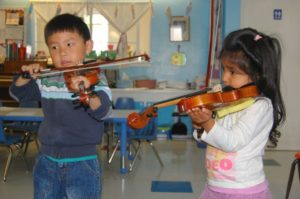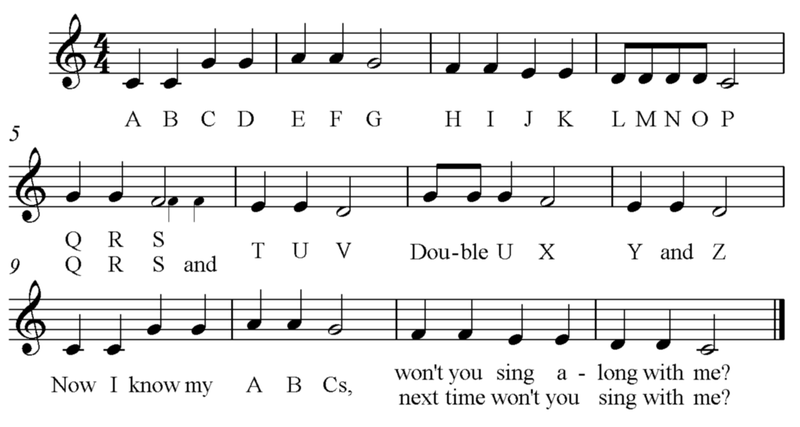From the first glimmer of recognition of “The Itsy-Bitsy Spider” or “Twinkle, Twinkle Little Star”, parents intuitively understand that music plays a positive role in their infant or toddler’s development. Singing or playing music soothes, engages and encourages children. Even when we speak to young children, we instinctively use sing-song tones, exaggerating the modulations of our voices. Parents and teachers have been teaching children the alphabet with the help of a song for almost two centuries (the song was copyrighted in 1835 by a music publisher; the tune is Mozart’s), along with a myriad of other nursery rhymes and songs.
Why do young children like to engage with music, and what do the studies say about its effects on their development? We researched the research to find out.
The Human Brain on Music
Cat scans show us that the various components of music (melody, rhythm, meter) affect different parts of the brain. Recognizing a song activates the left frontal lobe. Timbre? Right frontal lob. Pitch gets the left posterior fired up. Words to a song are processed on one side of the brain; the other side processes the music.
The full-brain activation caused by music results in better retention of information. Music and its components represent a more efficient method for the brain to commit information from short-term to long-term memory. So, even young children are able to memorize the 26 letters in the Alphabet in order – because they enter the brain through a simple tune and rhythmic structure.
The Powerful Ear
An Ear, Nose and Throat physician named Alfred Tomatis, whose research was fundamental to the field of audio-psycho-phonology, established a theory linking the ear with vocal production known as the Tomatis Effect. He posited that “the voice does not produce what the ear does not hear” – that is, damage to the muscles of the ear resulting in loss of hearing of certain registers influence what vocalizations can be made. He used this theory to address a diverse array of communication disorders including dyslexia, learning disabilities, attention deficit disorders, autism and sensory integration difficulties.
Dr. Tomatis also discovered that the ear is the most fully developed of the sense organs at birth, and that a person’s ability to hear affects many physical and emotional developments.
Musical Intelligence
In the first year of life outside the womb, children begin to narrow their vocalizations from universal human sounds to sounds heard in their own culture. It is widely held by early development specialists that young children should be exposed to the phonemes of foreign languages in their early years to assist with foreign language learning later in life.
A study done in 1992 by Harvard psychologist Howard Gardner cites musical intelligence as equal in importance to logical-mathematical, linguistic, spatial, bodily-kinesthetic, interperosnal and intrapersonal intelligence.
Audiation
A term coined by music education researcher Edwin Gordon in 1975 to help define musical processing, ‘audiation’ is to sound as ‘imagination’ is to images.
It is a widely established fact that the period of early childhood is critical to the development of musical intelligence. This period is known as the “music babble” stage, a time when the brain is wiring itself to receive music. Listening becomes a more complex process as the ear distinguishes between differences in pitch, melody and other musical components. A child may experiment with his or her own voice, or recognize certain “kinds” of music. Giving children the opportunity to learn how to sing in tune and march to a beat is a critical part of early education and could be considered a birthright, as music education professors Levinowitz and Guilmartin proposed in their collaborative studies (1989, 1992, 1996).
Music at Nomura Preschool
 Like many parents, Faith Nomura understood the connection between children’s engagement with music and successful development when she founded the daycare preschool in Berkeley in 1964. Music curricula at Nomura Preschool is a strong component of the day. Currently, the school brings in two specialized music teachers. One teacher visits the individual classrooms on Mondays and Thursdays, and another brings all the classes together for sing-alongs on Friday mornings. In addition to these musical opportunities, the school offers pre-piano and violin lessons for those interested in musical exploration on those instruments.
Like many parents, Faith Nomura understood the connection between children’s engagement with music and successful development when she founded the daycare preschool in Berkeley in 1964. Music curricula at Nomura Preschool is a strong component of the day. Currently, the school brings in two specialized music teachers. One teacher visits the individual classrooms on Mondays and Thursdays, and another brings all the classes together for sing-alongs on Friday mornings. In addition to these musical opportunities, the school offers pre-piano and violin lessons for those interested in musical exploration on those instruments.
And because movement is music’s natural partner, Nomura Preschool also offers extracurricular lessons in Karate, Creative Dance and Gymnastics.
When you sing, dance, and celebrate music with your child, you’re giving them a gift they’ll carry for a lifetime.
Sources
“Music and Movement – Instrumental in Language Development”, M. Harman M.A., Earlychildhood News
“The Importance of Music in Early Childhood”, L. Levinowitz, Ph.D., Music Together
“Alfred A. Tomatis”, Wikipedia
